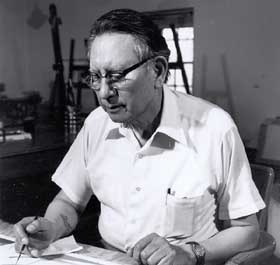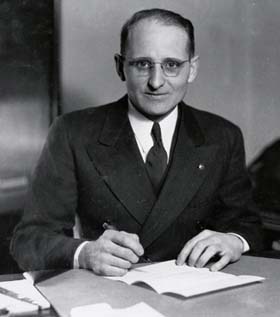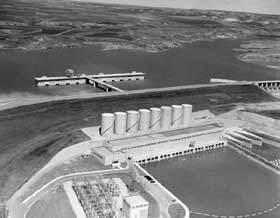Lesson 4
Oscar Howe and Francis Higbee Case
|
In 1933,
President Franklin Roosevelt created the New Deal. This
government program gave help to people during the Great
Depression. This was a time of business failures and drought
(read more about this in Unit 9). The New Deal gave jobs to
unemployed workers. People could then
pay their bills. In return, the country got roads, parks, dams,
and works of art.
|
|
|
|
|
Oscar Howe
|
|
|
As a child,
Oscar Howe drew in the dirt with sticks because he did not have
paper and pencils. He overcame many such troubles to become a great
artist. Howe was a Yanktonais Nakota (Sioux). He was born on the Crow
Creek Indian Reservation in 1915. He started school at the
Pierre Indian School. Then his troubles began. His mother died. An
eye disease nearly blinded him. He got a painful skin disease. He
went home to his grandmother to recover. She taught him many Nakota
traditions and symbols. He used these in his paintings.
|

Photo courtesy of South Dakota State
Historical Society
|
|
|
|

Photo courtesy of South Dakota State
Historical Society
|
|
|
Howe later went
back to school in New Mexico. Here he began studying art. He
graduated second in his class from the art program at the Santa Fe
Indian School. His work was shown in cities across the United
States. Howe came back to South Dakota during the Great Depression.
He began working for the Artists Project of the New Deal. He painted
murals in Mitchell and Mobridge.
The Second
World War (learn about this in Unit 9) ended the New Deal. Howe
served as a United States soldier. He went to North Africa and
Europe. When he came home, he began to work at the Mitchell Corn
Palace. He created murals of corn for this building. Howe also
started his college education. When he was done, he worked as art
director for the Pierre schools. Later he became a teacher at the
University of South Dakota. Howe’s art is known around the world.
He was artist laureate of South Dakota. He died in 1983, but his art
lives on.
|
|
|
|
|
Francis Higbee Case
|
|
Many changes
followed the Second World War. Projects began on the Missouri River.
Four big dams were built in South Dakota. They made
irrigation possible in dry years. In wet
years, they helped with flood control. The dams made
hydroelectric power in all seasons.
|
|

Photo courtesy of South Dakota State
Historical Society
|
Francis
Higbee Case helped bring these dams to South Dakota. He was born in
Iowa in 1896. His family moved to Sturgis when he was thirteen years
old. After college, Case went to work for the Rapid City Journal.
He later worked for the Hot Springs Star and the Custer
Chronicle. On the job, Case
promoted
the Black Hills. He asked President Calvin Coolidge to come to
Custer State Park. Coolidge took his vacation there in 1927. Tourism
boomed when the State Game Lodge became the Summer White
House.
|
|
In 1936, voters
elected Case to the United States House of Representatives. He
served seven terms in the House. He then moved to the Senate. In
Washington, Case promoted dam projects. His efforts helped to
fund four big dams on the Missouri River. Case was also known for
his work for weather modification. He thought that scientists could
change the weather. If it rained more, South Dakota farmers could
grow more crops. Case also worked for better highways across the
state and nation. He died in 1962.
|

Photo courtesy of South Dakota State
Historical Society
|
|
|
|
| Vocabulary |
|
| hydroelectric (adj.), making electricity by the force of
running water
irrigation (n.), bringing water to dry land through
ditches, pipes, or streams
murals (n.), paintings or other works of art done on
a wall or ceiling
|
promoted (v.), pushed to the front
unemployed (adj.), out of work; jobless
|
|
|